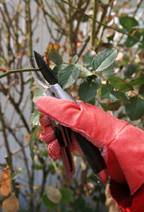Few people will argue with the fact that it’s time to reshape our companies to respond to current changes in the economy. One way to view the needed changes that we need to make is to compare them to pruning a tree.
To a tree, pruning is like cutting your fingernails. Although it can be a little uncomfortable, it is necessary maintenance appropriate for the season the tree is passing through, similar cutting your fingernails every week to ten days.
Most of us don’t relish the thought of wrestling through a difficult year or two as we fight to keep our jobs and businesses healthy. On the other hand, perhaps there are benefits to this season that we can look to as we push our way through.
One of my sons called wanting some advice as he prepared to cut back some seriously overgrown rose bushes. He has graduated from medical school, has moved into his fist home and had found an old pair of pruning shears.
 We discussed how overgrown his bushes had become and planned an attack. It sounded like his idea was to simply whack them back to the ground. But as we talked and discussed the types of wood in the plant and reviewed a few basic principles of pruning, he was glad he made the call to his garden-loving Dad and that he had avoided the temptation to cut to the root.
We discussed how overgrown his bushes had become and planned an attack. It sounded like his idea was to simply whack them back to the ground. But as we talked and discussed the types of wood in the plant and reviewed a few basic principles of pruning, he was glad he made the call to his garden-loving Dad and that he had avoided the temptation to cut to the root.
Like pruning in the winter months, these tough economic times aren’t all bad either. I’ve found that we tend to get a little lazy and sloppy during long seasons of prosperity. But if we pay attention to nature, we can notice that nature’s seasons provide a good example of how we can operate during economic slow downs.
Prune With Care
Have things become a little overgrown around your company, or in your job? Growth is good, it produces valuable fruit needed to sustain and nourish us. But wild growth left unmanaged produces a twisted and unproductive plant that will become weak and useless if left unchecked for too many seasons.
So how do you prune a company? In horticulture the first cuts are made to the suckers. These branches grow up in the middle of a plant, suck the energy out during the summer months, have the appearance of new growth, but actually never produce fruit. So they’re the first that gets trimmed. They’ve got to go.
The next to get cut is the dead wood. Dead wood is found at the end of some strong branches where growth was allowed to happen, but this part of the tree is no longer useful or needed. These get cut back a little into the healthy part of the plant, where I’m sure it hurts a little because the plant will often “bleed” a few drops. But it quickly scars over and flourishes, once spring arrives.
Budding New Growth
Once the pruning is completed, the plant looks quite different than it did before. It appears a little scarce and lacking. But the cold season soon passes and a miracle happens. Close behind each cut, budding new growth begins. New life springs from the old branch with vigor and strength. The plant surges with renewed momentum and springs back into full life once again. The plant is stronger and better than ever before and it moves into a new season.
The Value of a Parable
The worth of a parable is that you can take it with you. These principles guide us through tough times and provide a scale we can use to measure each action and decision against as we move through the seasons that we pass through.
These times strip away the unnecessary, clean us up, allow us to see what’s really essential and grasp tight to what is really important. You can use this time to focus on the dead wood that’s cast into the fire of current world news and politics, or you can use it to make needed changes and get back to the basics that have made you successful in the past.
If the level of success that you desire has eluded you in the past, this is the season to make the changes necessary to assure that your success in the next season will be here before you know it.
One more point to consider. As with the tree, the ideal time to prune is while it’s still cold. If you wait too long, there isn’t enough time for the healing process to respond before the heat comes and the growth surge begins. Pruning during the warm season forces the plant to bleed unnecessarily and leaves it open to infection. Pruning is always best during the cold seasons.
Tending the Plant
During the cooler months, pruning isn’t the only activity you can engage in to strengthen the plant. It’s time to clean and bind wounds in the plant. It’s time to loosen the soil at the base of the tree and add some fertilizer and nutrients to prepare for the coming season. Look for parallels in your job or company to see what action you can take to assure a good harvest next fall.
